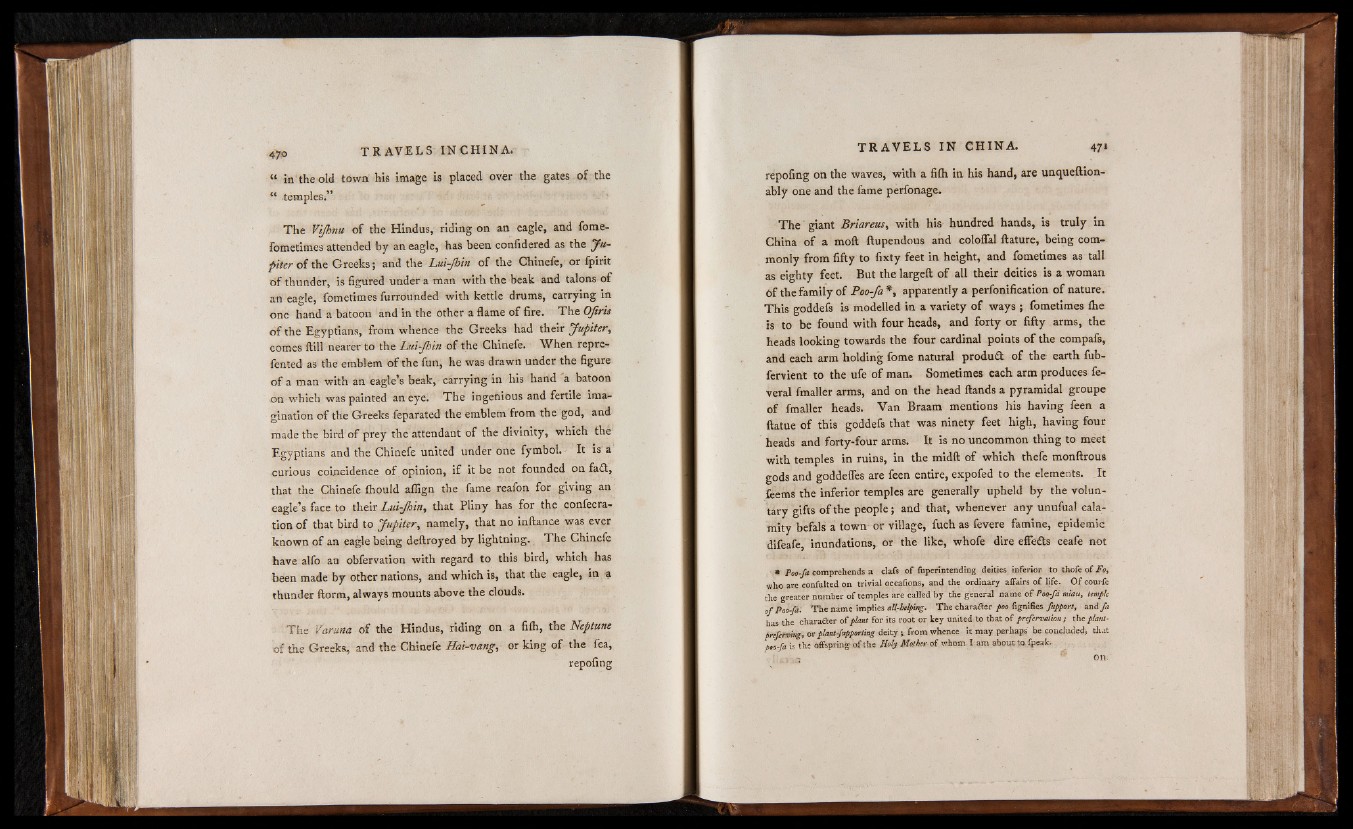
“ in the old town his image is placed over the gates o f the
“ temples.”
T he Vijhnti o f the Hindus, riding on an eagle, and fome-
Fometimes attended b y an eagle,-has been confidered as the J u piter
o f the Greeks ; and the Lui-Jhin o f the Chinefe,'or fpirit
o f thunder, is figured under a man with the beak and talons o f
an eagle, fometimes furrounded with kettle drums, carrying in
one hand a batoon and in the other a flame o f fire. The OJiris
o f the Egyptians, from whence the Greeks had their Jupiter,
comes ftill nearer to the Lui-Jhin o f the Chinefe. When repre-
fented as the emblem o f the fun, he was drawn under the figure
o f a man with an eagle's beak, carrying in his hand a batoon
on which was painted an eye. The ingenious and fertile imagination
o f the Greeks feparated the emblem from the god, and
made the bird o f prey the attendant o f the divinity, which thé
Egyptians and the Chinefe united under one fymbol. * It is a
curious coincidence o f opinion, if it be not founded on fact,
that the Chinefe Ihould aflign the fame reafon for giving an
eagle’ s face to their Lui-Jhin, that Pliny has for the confecra-
tion o f that bird to Jupiter, namely, that no inftance was ever
known o f an eagle being deftroyed by lightning. The Chinefe
have alfo an obfervation with regard to this bird, which has
been made by other nations, and which is, that the eagle, in a
thunder ftorm, always mounts above the clouds.
The Varuna o f the Hindus, riding on a fiih, the Neptune
o f the Greeks, and the Chinefe Hai-vang, or king o f the fea,
repofing
repofing on the waves, with a fiih in his hand, are unqueftion-
ably one and the fame perfonage.
The giant Briareus, with his hundred hands, is truly in
Chitia o f a moft ftupendous and cololfal ftature, being commonly
from fifty to fixty feet in height, and fometimes as tall
as eighty feet. But the largeft o f all their deities is a woman
Of the family o f Poo-fa * , apparently a perfonification o f nature.
This goddefs is modelled in a variety o f ways ; fometimes ihe
is to be found with four heads, and forty or fifty arms, the
heads looking towards the four cardinal points o f the compafs,
and each arm holding fome natural produft o f the earth fub-
fervient to the ufe o f man. Sometimes each arm produces fe~
veral fmaller arms, and on the head ftands a pyramidal groupe
o f fmaller heads. Van Braam mentions his having feen a
ftatue o f this goddefs that was ninety feet high, having four
heads and forty-four arms. It is no uncommon thing to meet
with temples in ruins, in the midft o f which thefe monftrous
gods and goddefles are feen entire, expofed to the elements. It
feems the inferior temples are generally upheld by the voluntary
gifts o f the people; and that, whenever any unufual calamity
befals a town or village, fuch as fevere famine, epidemic
difeafe, inundations, or the like, whofe dire eflfe&s eeafe not
* Poo-fa comprehends a clafs o f fuperintending deities inferior- to thofe of Fo,
who are confalted on trivial occafipns, and the ordinary affairs o f Ufe, O f courfe
the greater number of temples are called by the general name o f Poo-fa mtati, ttmplc
of Poo-fa '. The name implies all-helping. The charafler poo figniSes fuppert, and fa
has the charafler of plant for its root or key united to that o f prefervalion ; the p/ant-
pnferoing, or plant fipporting deity ; from whence it may perhaps be concluded, that
poof a is the offspring o f the Holy Mother of whom I am about tofpsak.